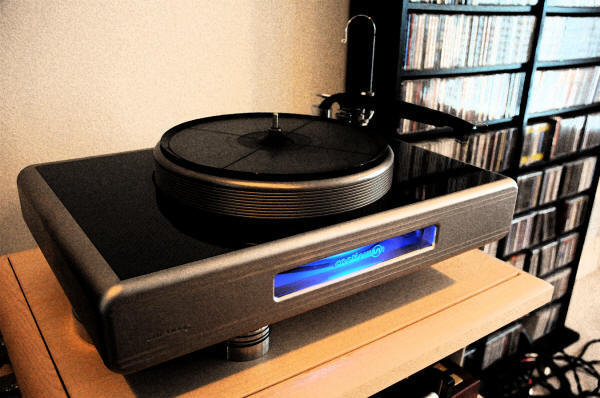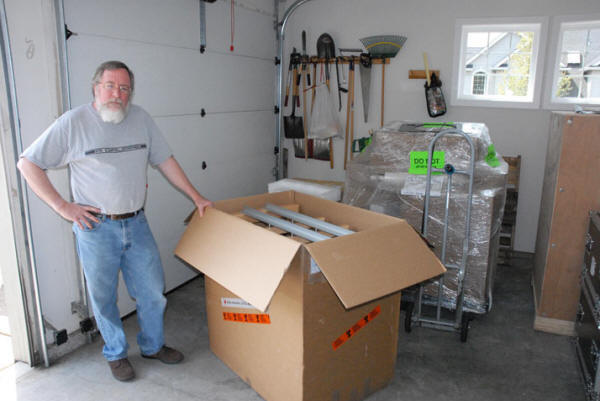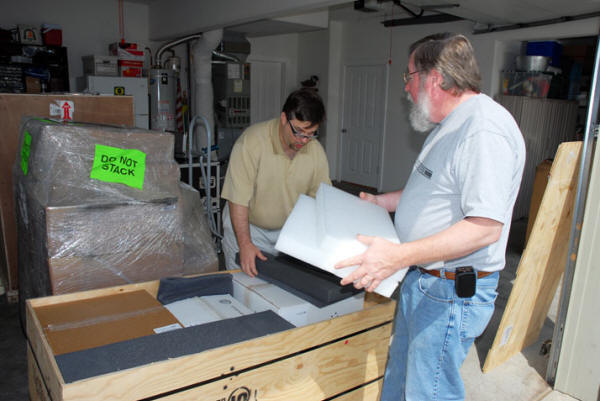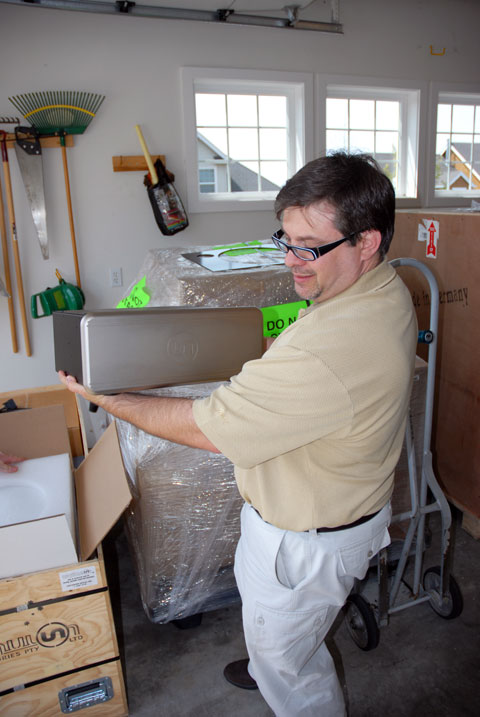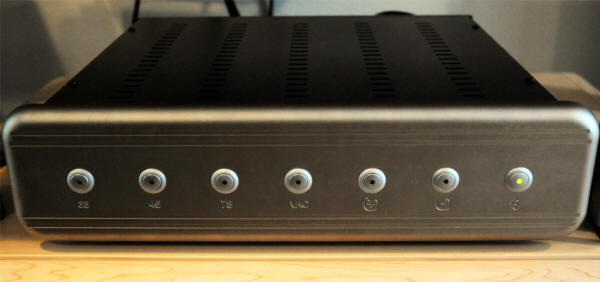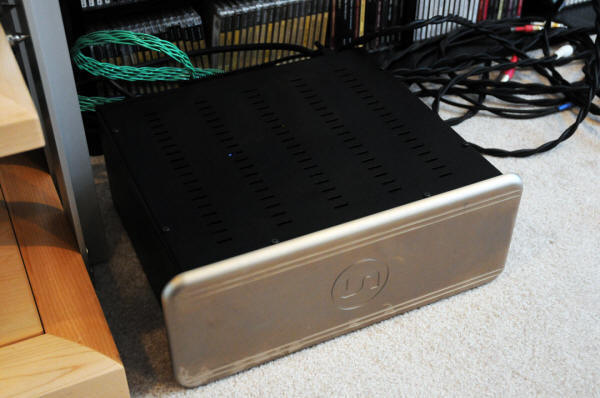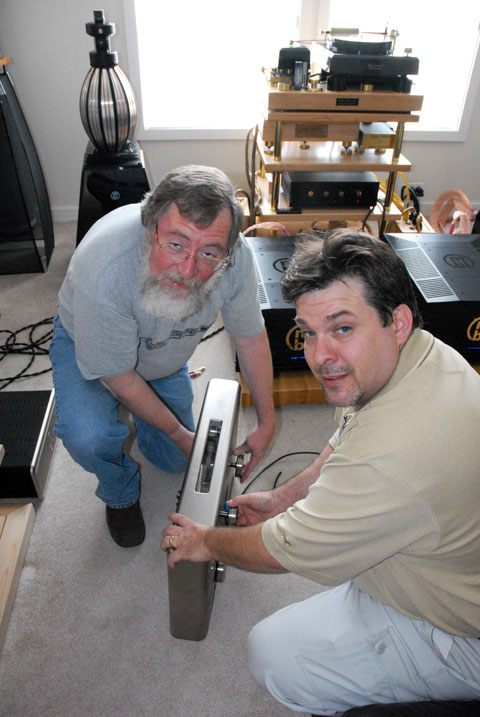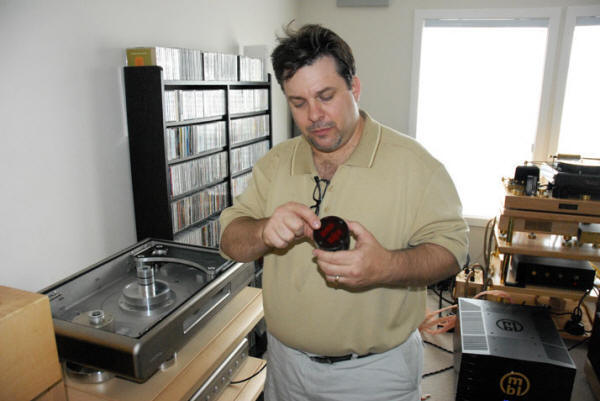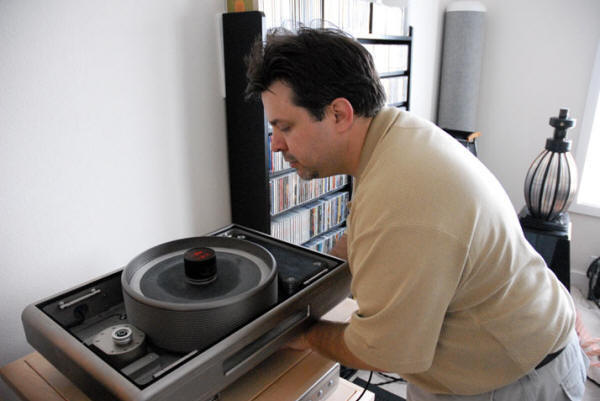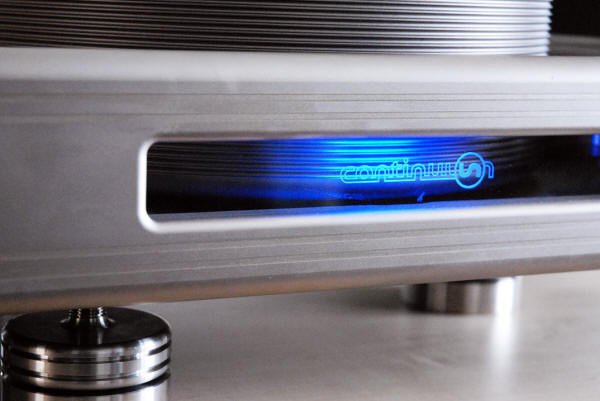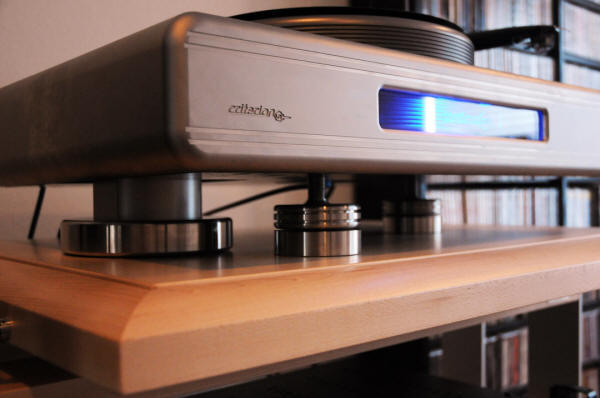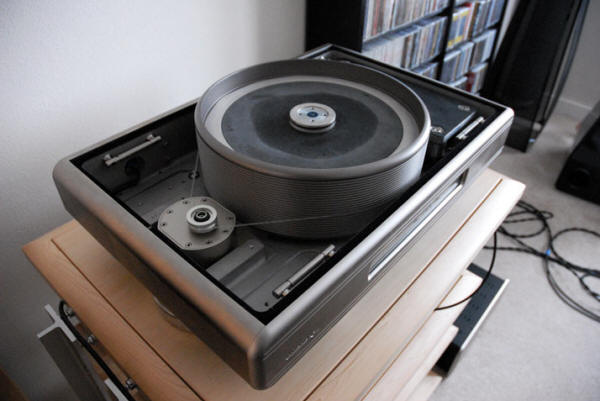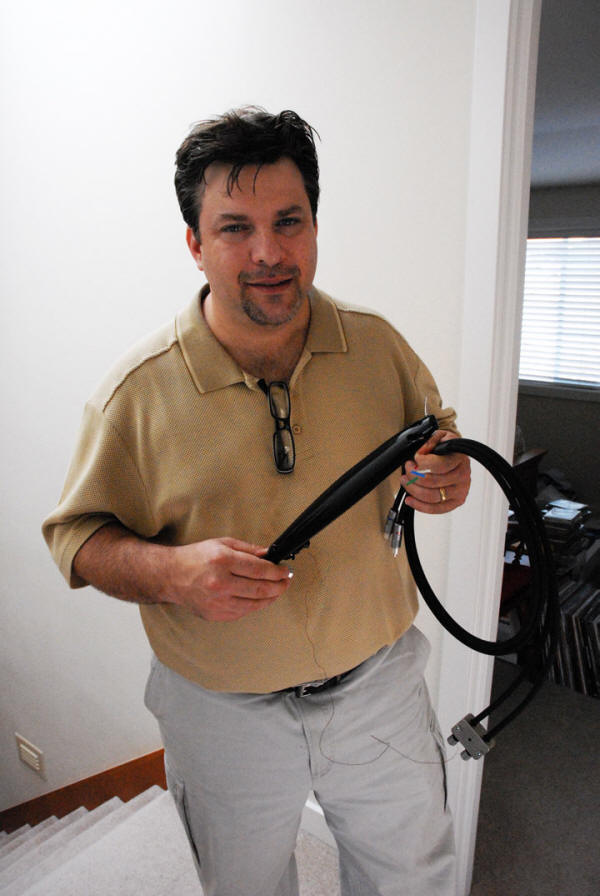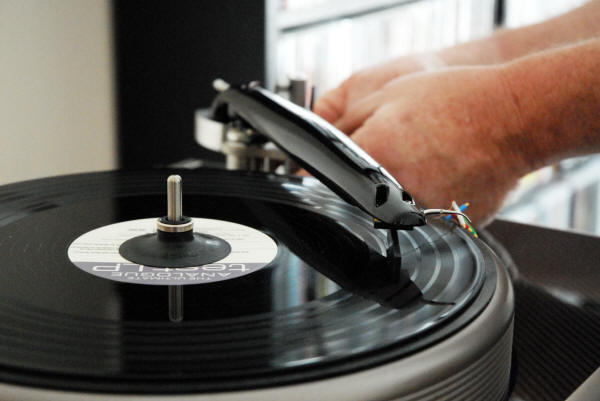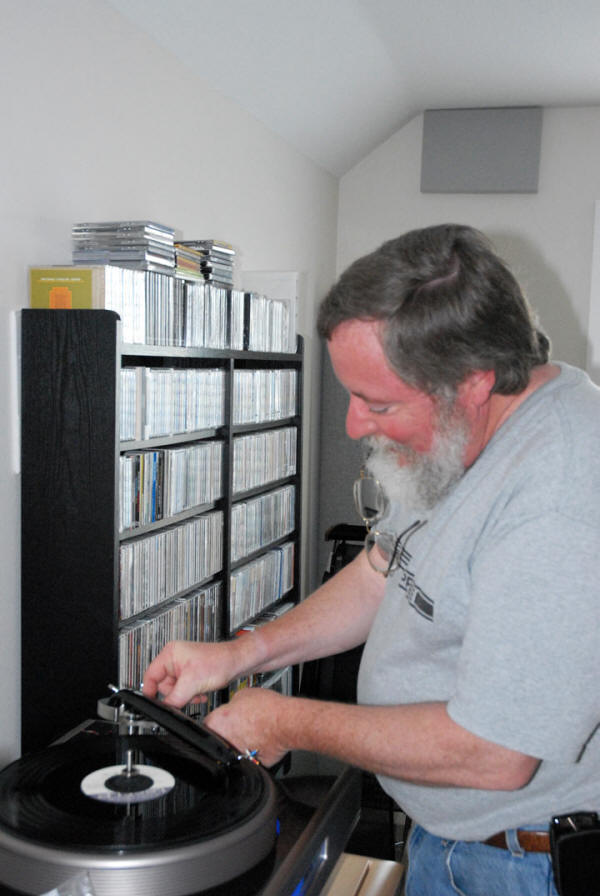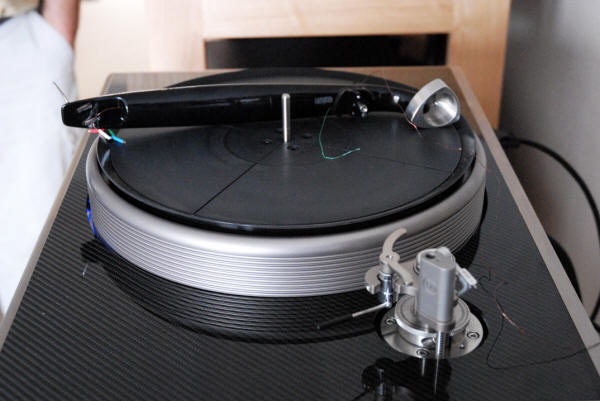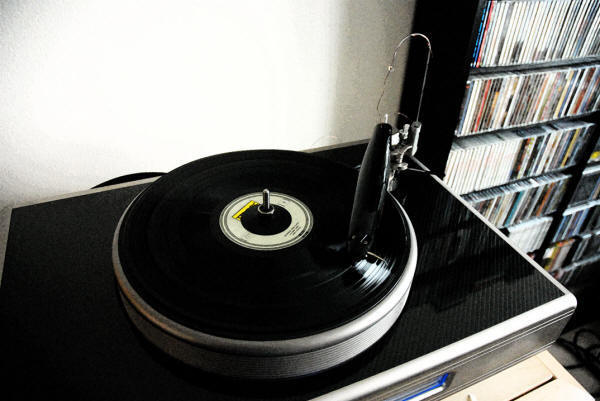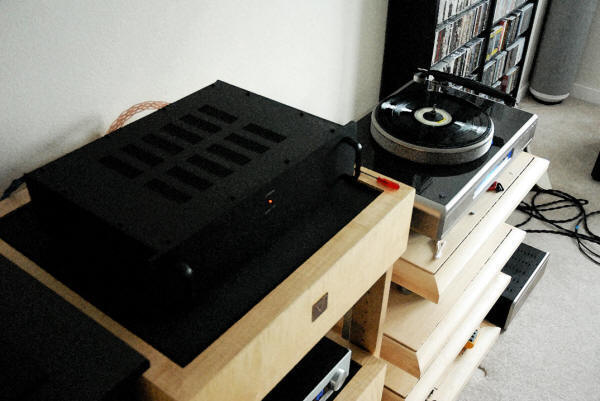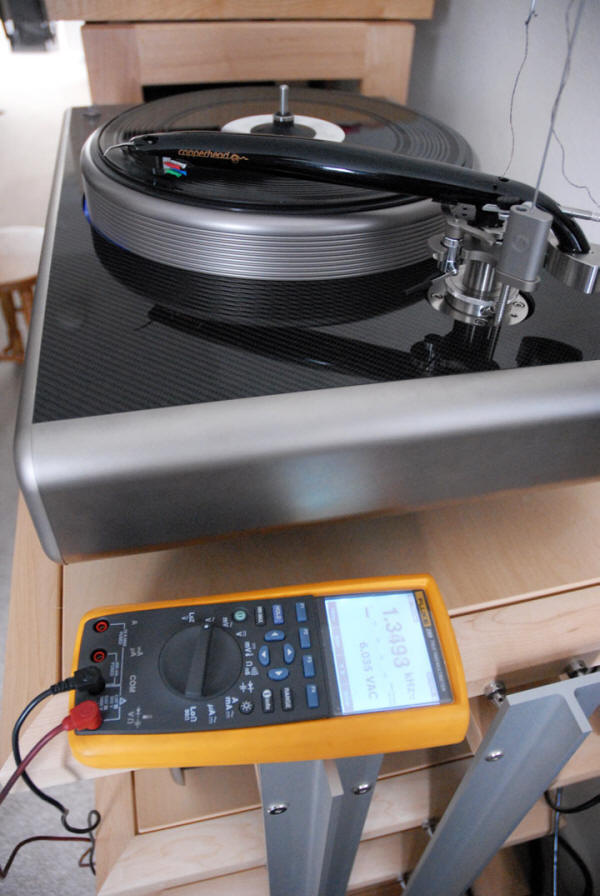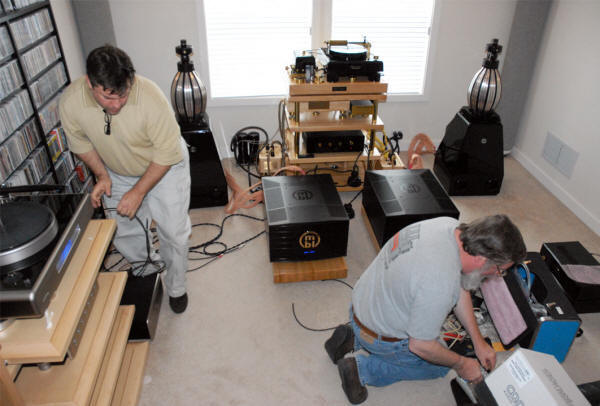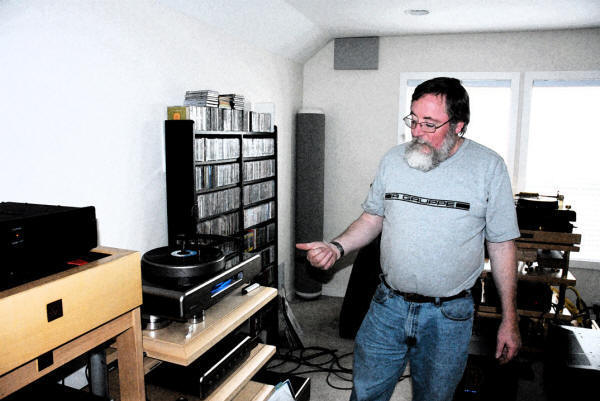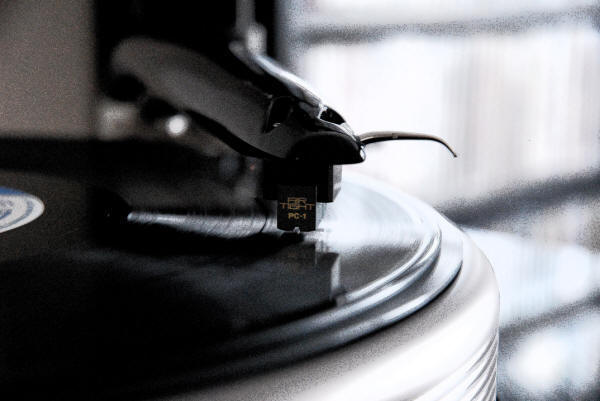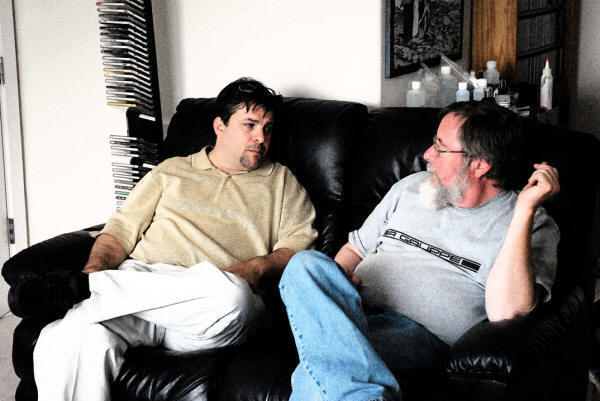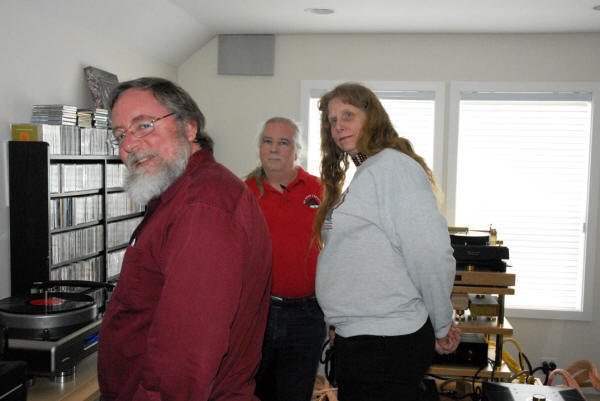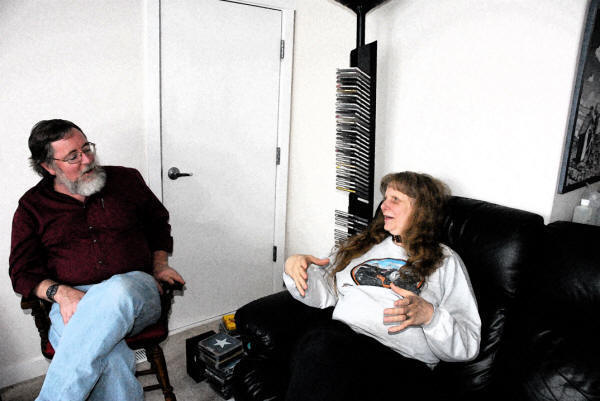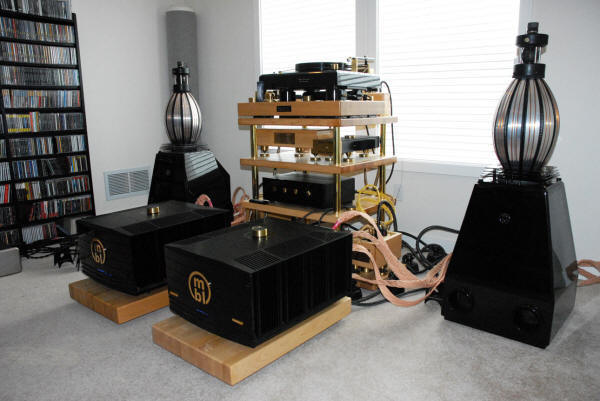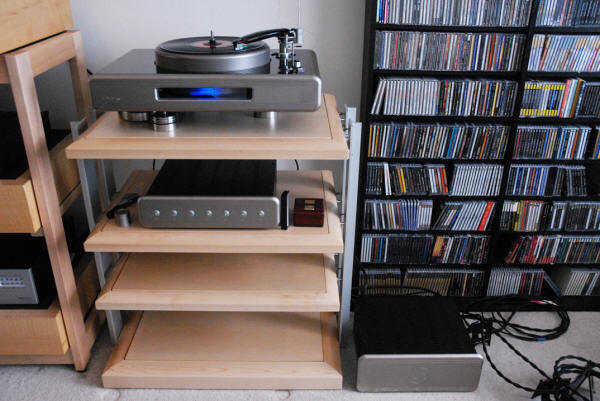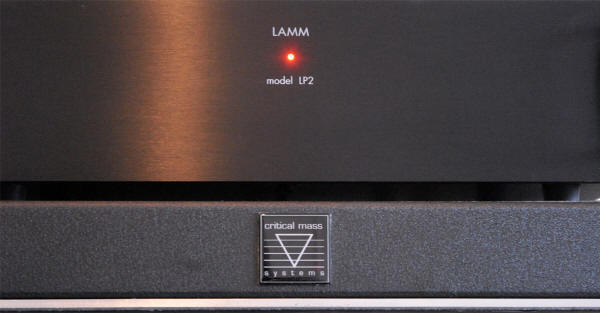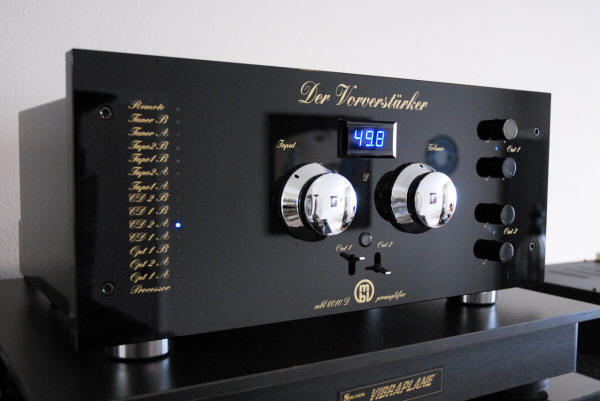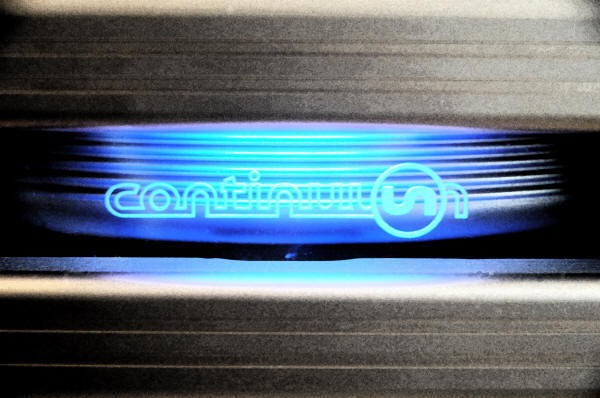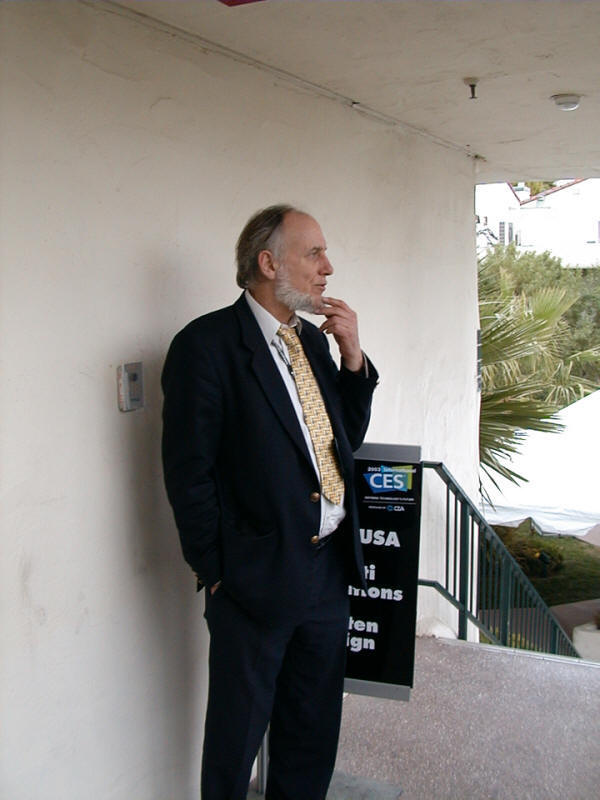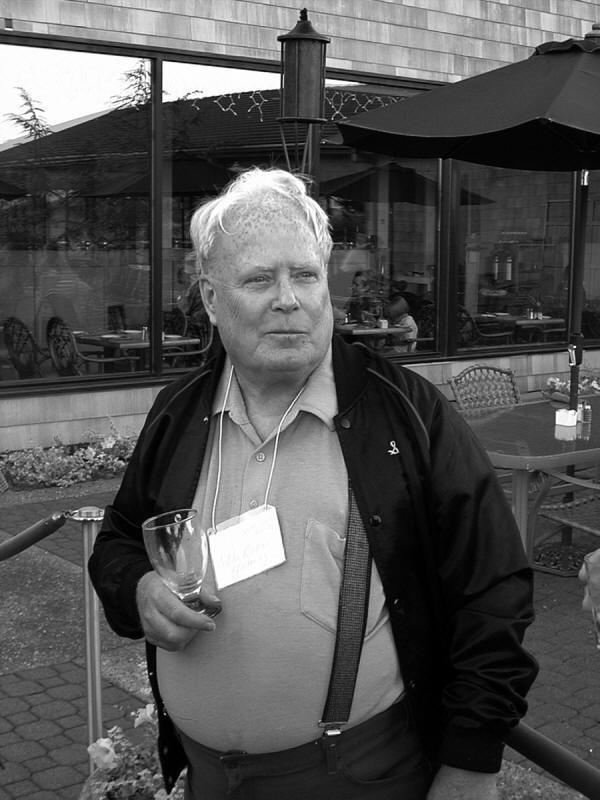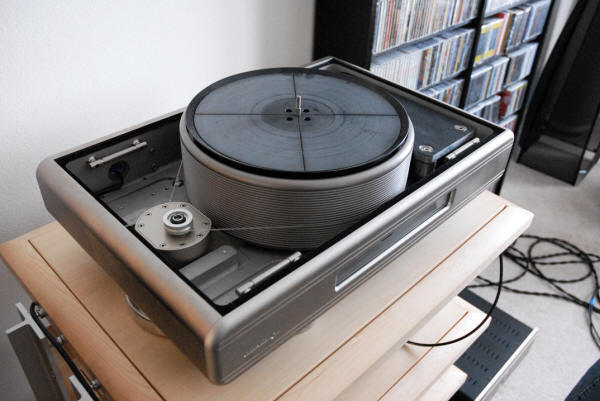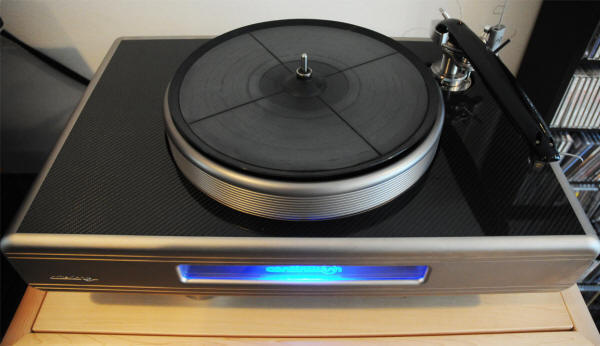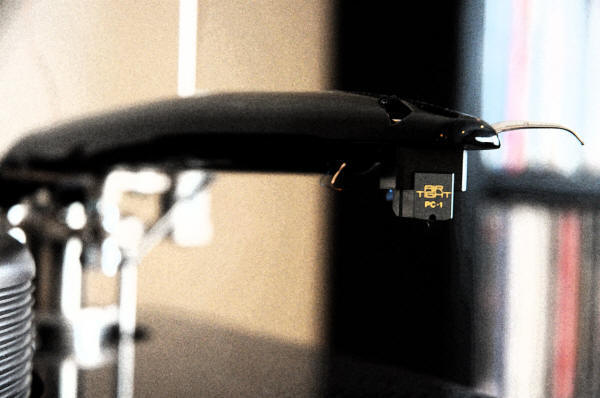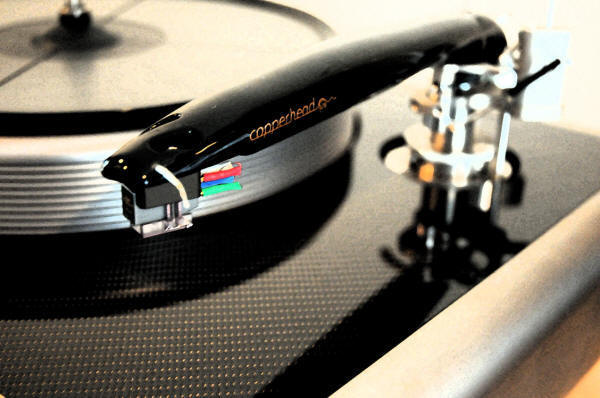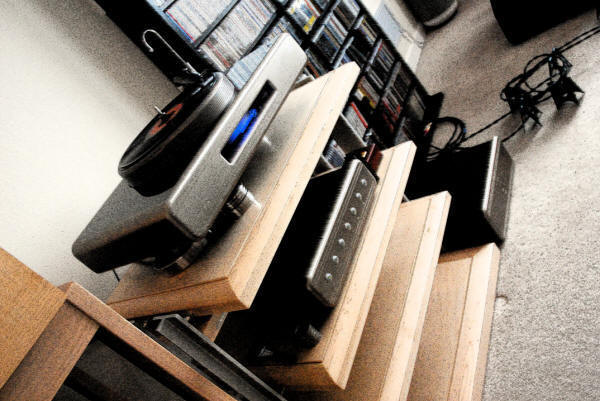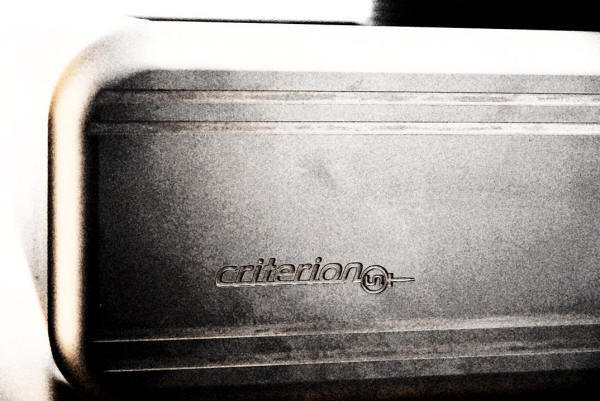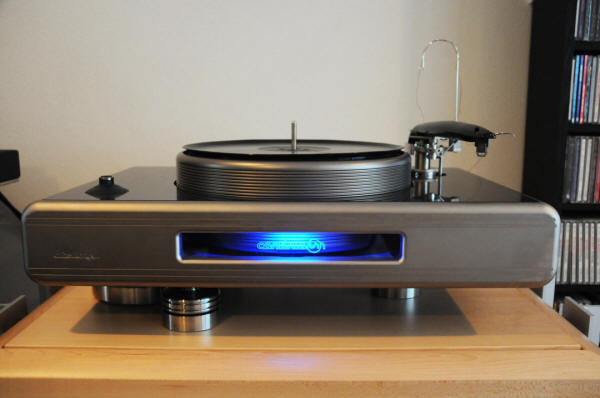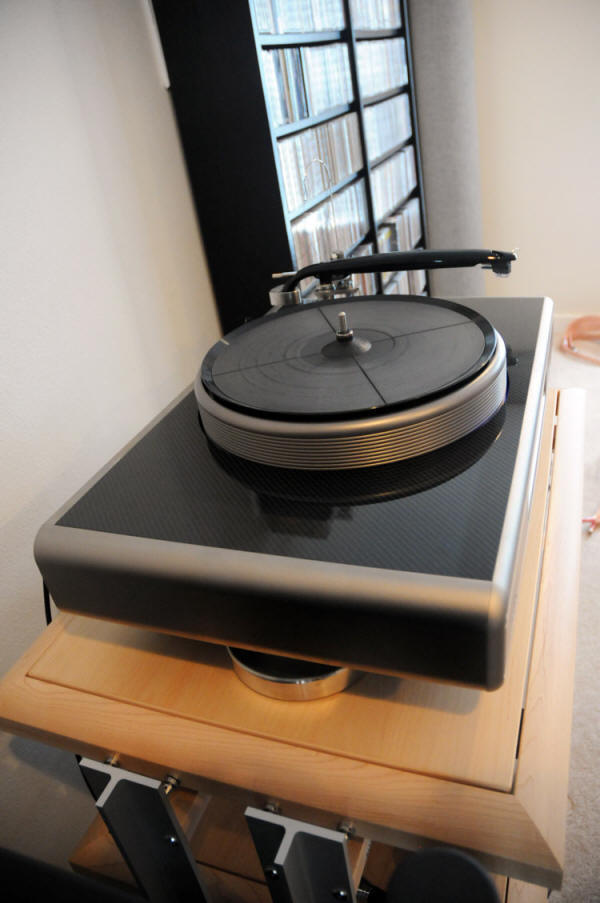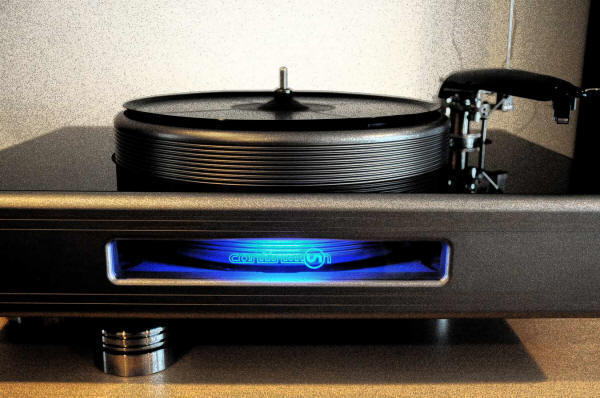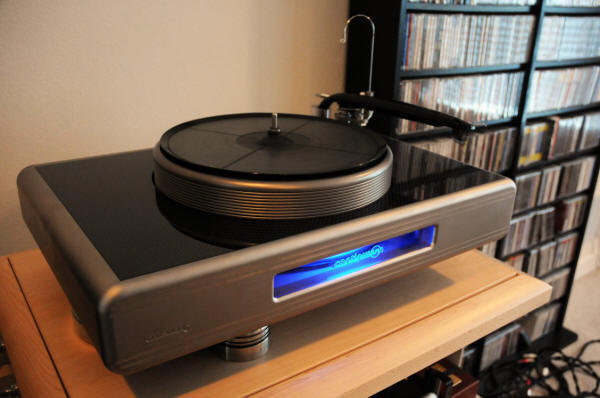|
You are reading the older HTML site Positive Feedback ISSUE 45september/october 2009
Impressions: The
Continuum Criterion turntable, Copperhead tonearm,
Air Tight PC-1 MC cartridge, and LAMM LP2 phono amp,
a photo essay With sidebar commentaries by Chris Sommovigo of The Signals Collection and Mark Doehmann of Continuum
[All photographs, image editing, and effects by Robinson] It's been long, too long, since my last jottings here. Most of the past year has been preoccupied with professional and personal concerns far from the roistering of fine audio, with toils, temptations, and trials on every hand… my silence has not been golden. It's not that I've been avoiding audio and video; far from it. I've been listening and watching in many settings and formats… east coast (where I was) and west coast (where I've returned, thankfully)… and have a substantial handful of projects that I'm working on right now. But exhaustion and other professional projects had me in a completely different track. Enough. Back to fine audio/video; there are several key projects overdue in my queue, and I need to break that logjam. Thanks to my audio friends who have been patient, waiting for these notes to be published. Back to Turntables: Enter the Continuum Criterion It's been a while since I evaluated a turntable. As always, turntable logistics are a bear; probably 40% of the projects that I've tried to put together over the years have piled up on the rocks of product availability, backlogs, custom building, schedule coordination, overseas shipping costs, distributor gnarliness, and so on. Frustrating stuff, believe me. And that's particularly true since only LPs and SACDs (plus the occasional open reel tape that I can find) really float my audio boat. (I do have Blu Ray high-resolution audio under evaluation right now, however; we'll see if I amend that statement in the near future.) I have a few thousand LPs around, with some really terrific music… I really love great vinyl. And it's sad to find as many obstacles as I do in the way of regular 'table evaluations. This means that nowadays I only mess with turntable reviews when I'm really sure that the parts and pieces can come together. Which, I am glad to say, happened in the Spring and Summer of 2008 with the Continuum Criterion. How did that happen? Easy. I cheated. It helps to know the US distributor for a turntable line, and it turns out that Continuum's USA distributor is an old and good friend of mine, Chris Sommovigo, of The Signal Collection. Chris has been a huge fan of licorice pizzas for beaucoup years, is an incurable vinylholic, and thus is a congenial kind of guy. Simpatico! After a CES set with the Continuum Caliburn, I had put the Continnum line down as one to keep an ear on… clearly these folks were on to some good things in their design work. When I reached a good time in my review schedule to talk about it, I put the question to Chris: what about a Continuum review? As it turned out, the Caliburn wasn't available (is it ever?), but the tandem of the Criterion turntable and the Copperhead tonearm could be sent to me. So far, so good. The next question was which MC was recommended for the Copperhead. This is a tricky thing, newbies; as I've noted in past turntable reviews, you should not just sling a turntable/tonearm/MC together willy-nilly. (Nor, for that matter, should your isolation platform and cabling be ignored, but that's dangerously close to a truism… it applies to everything in fine audio/video.) Since Chris had gotten some good results from the Air Tight PC-1, and had one in inventory, it would come along for the ride. He also had a Finite Elemente Pagode Master Reference equipment rack on hand that would provide a platform for the Criterion during the review. PFO would supply the phono amp (the impeccable Lamm LP2), cabling (JENA Labs ONE and Silent Source), and the power enhancement (Walker Audio's Velocitor). And the LPs! Lots of those. I have to say that Chris was tremendously helpful throughout. He and Rich O'Neill, his setup specialist would fly in for the deployment, so all was Jake. Bye-bye to painful logistical problems, thanks to Continuum, Sommovigo & Company. What follows is a photo essay of the setup and dial-in, with my evaluative comments afterwards. The Setup
Rich O'Neill demonstrates impeccable technique (and gaze) while "de-boxing" the Finite Elemente equipment rack. Rich really knows his analog(ue) stuff, and impressed us with his skill and toolset during setup. Good guy, too!
More to the point: Chris Sommovigo and Rich O'Neill opening the Christmas presents from Continuum. Very impressive packaging; built like a tank, the way that all Monkey Coffins should be. (No, I am not kidding; substandard packaging/crating bothers me a lot. It should concern you too.) Chris and Rich arrived at the end of April, 2008, to deliver the goods and begin the process of unboxing and assembling the equipment. Both gents are great fellows, audio lovers, know their stuff, and went right to work. In short time, our garage here in River City started to fill up with crate guts, boxes, gizzards, and packing materials.
Chris triumphantly displays the vacuum pump/power supply of the Continuum Criterion. Beefy stuff! I'd give him about 8.0 out of 10 on his muscle-man stance. When will the Olympics add Power Supply Clean and Jerk to their events?
Wowzers. Here's the main Control Unit for the Criterion, resting in place on a shelf in the Finite Elemente. Speeds of 33.3, 45 and even 78—impressive. The VAC button initiates the vacuum hold-down system; the + button increases turntable rotation, while the—dials it down. The far right button is power on/off.
And here's the vacuum pump/power supply nicely cabled with JENA Labs plumbing. Very substantial.
In which our audio heroes mount the pods on the Criterion chassis. It may look simple and fairly compact, but there's much more to this turntable than meets the eye.
With the Continuum Criterion chassis in place on the Finite Elemente rack, the next step is to get the platter and plinth into place. Chris examines The Cartridge Man Digital Leveling Gauge in preparation for its use.
With the drive under-assembly in place, Chris does an initial check of the level, and begins the adjustment of the Criterion's pods before installing the drive belt system.
The pods of the Criterion are substantial, by the way. According to Chris Sommovigo, [these are actually identical to each other—locations are symmetrical, but were chosen by FEA analysis for best locale, and are precisely located according to supercomputer-calculated optimums.
According to Continuum, this counter-intuitive configuration was calculated by an Australian supercomputer as the one that would provide maximum resonance control, and thus optimum neutrality for LP playback.
After a bit of noodging and pod adjustment, the Criterion comes nicely into level.
Spot on! The Criterion is now ready for the next step…
…the Copperhead tonearm. Chris stands ready to launch, after he and Rich complete the preparations.
Rich checks the platter's vacuum hold-down and auto-slider record clamp.
With the carbon fiber plinth and the platter in place, next comes the adjustment of the Copperhead tonearm mount and the dialing in of the Air Tight PC-1 MC cartridge (which is obviously not yet mounted). That's "The Ultimate Analogue Test LP" on the platter; a good test LP is an essential part of turntable setup.
Rich begins work on adjusting the initial proper level of the Copperhead.
Here's a rare sight: the Copperhead tonearm on its side, exposing the tonearm mount.
Next Rich and Chris check the tracking force. It needs to be 2.0 grams; you can see that they're close in this watercolor image.
Here's a side view of the unique profile offered by the Copperhead. Composed of resin, hollow throughout most of its cross-section, the Copperhead tonearm is unlike most that you'll see. It's now ready for proper fine tuning of its Vertical Tracking Angle (VTA).
The assembled Criterion/Copperhead in fresco, with the Air Tight PC-1 in place; now a Telarc OMNIDISC LP is used to help dial-in the tonearm's anti-skating and get the Air Tight PC-1 tweaked for top performance.
Here's a watercolor of the superb Lamm LP2 phono amp in place next door on the Critical Mass Systems Grandmaster Black rack and isolation platform system.
Rich uses a Fluke Digital Multi-Meter (DMM) to dial in the test tones precisely. He's sneaking up on the 1kHz tone in this photograph; some tweaking is still necessary.
Having hit the range with the Criterion/Copperhead/PC-1, Chris and Rich work on packing up the loose ends. In the background are a pair of the mbl 9008 amps in monoblock mode, as well as the exceptional mbl 101 Radialstrahler omni-directional speakers. Superb!
Chris Sommovigo al fresco, immediately after the Criterion has been setup…mission accomplished. It's a very good thing to love what you do….
Rich O'Neil, likewise in fresco, discussing the merits of the Criterion. Throughout this project, Rich proved to be extremely knowledgeable, and was able to dial-in the tandem of the Copperhead and the Air Tight PC-1 with impressive efficiency. Like Chris, he's also a lot of fun to listen to great LPs with.
The Air Tight PC-1 properly configured, and in action… a thing of beauty!
Chris Sommovigo and Rich O'Neil confer during the post-setup listening session. Mission accomplished!
During a second listening session a couple of months later, Rich O'Neil got a chance to meet with Michael and Jennifer Crock of JENA Labs. This gave us an opportunity to hear the striking difference that the JENA Labs Model ONE power cable makes to the Continuum Criterion system. The improvement was not subtle.
Michael Crock zooms in on the Criterion in action. In the background, the Lamm LP2 phono amp rests on the new rack that it had been transferred to by this time in the evaluation, the Critical Mass Systems PXK. To say that this was a rack upgrade over the CMS Grandmaster Black would be a real understatement….
Rich and Jennifer yakking it up over the finer points of analogics and fine audio reproduction. Sorry, no transcript available! The Rest of the Playback System The Continuum Criterion/Copperhead and Air Tight PC-1 on the Finite Elemente rack were in rare and exceptionally good company during this evaluation. The rest of the circuit maximus consisted of a set from mbl, whose synergy, beauty, and transforming sonic quality is such that I will be writing on them in a parallel essay: the 6010 D preamp, a pair of 9008 monoblock amplifiers, and the 101 Radialstrahler omnidirectional speakers. In addition to the Criterion turntable, my other reference source was the Playback Designs MPS-5 SACD/CD player. (See my review of the MPS-5 in PFO Issue 39, at https://positive-feedback.com/Issue39/playbackdesigns_mps5.htm.) Power cabling was provided mainly by Silent Source, with a JENA Labs Model ONE on the MPS-5 (an enhancement to the performance of the MPS-5 that I consider to be sine qua non.) The Walker Audio Velocitor provided line enhancement on the source end; the dual AC's per monoblock of the mbl 9008's were plugged directly into the wall, each pair of Silent Source AC cables having its own dual-duplex 20 amp dedicated outlet. Other isolation shelving was provided by Vibraplane/Black Diamond Racing/Michael Green (6010 D preamp), Walker Audio's Prologue amplifier racks (9008 monoblocks), and Critical Mass Systems' Grandmaster Black rack and shelf system (Lamm LP2 phono amp, and the EMM Labs CDSD SE transport and DCC2 SE preamp). I should note that the Grandmaster Black was replaced later in the review with the next step up in the Critical Mass Systems line, the PXK, definitely improving the sound of both LP and SACD playback.
The mbl 9008s on their Walker Audio Prologue Reference amp stands, with the mbl 101's in place, cabled with double runs of JENA Labs Pathfinder/Symphony. In the background is the Walker Audio Proscenium Black Diamond turntable system, with Jud Barber's LPA-150, on a Prologue Reference rack. You can just make out the Criterion power supply at the left edge of the photograph.
The Criterion on the top shelf of the Finite Elemente Pagode Master Reference Rack; the next level down is the Criterion Master Control Center. On the floor rests the vacuum pump/power supply. The main power cabling was via JENA Labs. The Critical Mass Systems Grandmaster Black Rack with the EMM Labs components is just visible to the left of this image.
Lamm's very fine LP2 Phono Amp rests on the top shelf of the Critical Mass Systems PXK rack system, which replaced the CMS Grandmaster Black that the evaluation started with. The CMS Grandmaster Black is very fine, but the CMS PXK is discernibly better. The PXK definitely improved the sound of the LP2, which benefitted my ability to critique the Criterion/Copperhead/PC-1. The Lamm LP2 proved itself to be a very well-matched and revealing component in the audio chain between the Criterion/Copperhead/Air Tight PC-1 and the mbl 6010 D preamplifier.
The Lamm LP2 took the output of the Criterion and talked downstream to the the mbl 6010 D reference preamplifier in its place on the Vibraplane: its performance was absolutely above reproach…and it's yowzah gorgeous, too! I really was spoiled, you know… and no one complained of sonic results, either. Deep Technology
In past years I've talked about the beastly challenge that the seemingly simple task of pulling signals out of vinyl grooves accurately poses to audio engineers and designers. I've gotten some excellent opportunities to hear several fine turntables in the intimately-known precincts of my own listening room, and have shared my thoughts with PFO readers over the years. If you're new to turntables, or if your knowledge/experience is limited, you might want to take a look at some of what I've written on the subject. For what it's worth, you'll find my past commentary and notes about the mysteries of turntables at the following links:
All of the above is in addition to many years (twenty now!) with my trusty-rusty Linn LP-12/Ekos/Arkiv/Cirkus/Trampolin/Lingo system, a Linto (sold quite a while ago) and my EAR 324. Beyond that, I've gotten to hear tons of turntables at various shows over the past fifteen years…more than I'd care to think about, actually. Throughout all of this, I've gotten a chance to see and hear a number of approaches to the Sisyphean task of LP audio reproduction: the optimum playback of whatever is in those devilish, seductive vinyl grooves. It really does look so easy. And it really is anything but. As Tim de Paravicini once told me regarding master tape playback at CES 2003, really quite passionately: "David, the problem is not in recording music. We can do that. You wouldn't believe how good even tapes from 1950 are. That isn't the challenge. The problem is in the playback!"
Tim de Paravicini at CES 2003, during our conversation about the challenge of playback in open reel tape and turntable systems. Ditto vinyl and turntables. We can inscribe the grooves remarkably well, with incredible dynamic range, exceptionally low inherent noise, unbelievable frequency response, excellent channel separation, terrific linearity, etc., etc., etc. (Just ask Stan Ricker!)
Speaking of master audio engineers, here's that Guru of the Grooves, Stan "The Man!" Ricker at VSAC 2001… affectionate portrait by yours truly. Stan has forgotten more about LP mastering and playback than most folks ever knew. But just try playing back what's in those grooves. Our licorice pizzas mock us, scoffing at (most of) our efforts to coax their deeper secrets out into our listening rooms. We scowl and pace restlessly, sensing that our LPs are holding out on us—and, most of the time, they are, the faithless wenches! Only our very best efforts show us what can still be, sometimes decades after their pressing, with these vinyl anachronisms that refuse to dry up and die…except with those who don't know better, whose idea of quality is fully encompassed by their iPod or MP3 player and a pair of ear buds. Sad stuff, Maynard. Our response to vinyl effrontery has been an avalanche of designs, confusing the typical audiophile/music lover with the variety that's erupted. Spring suspension. Solid suspension. Air suspension. Linear tracking tonearms. Uni-pivots. Bi-pivots. Integrated tonearm and plinth. Separate tonearm and motor drive pods. Belt-driven platters… no, no! Direct drive platters! Inverted bearings. Air bearings. Magnetic bearings. VTA on the fly… no, VTA only after stopping and parking. Record clamps. No record clamps. Vacuum hold down. No vacuum hold down. Vacuum hold down plus record clamp… or maybe not. Dampened tonearms; non-dampened, the same. Mass-loaded chassis and platters; HUMONGOUS mass loaded chassis and platters; very light chassis and platters. Very short tonearms… very long tonearms… high compliance, medium compliance, low compliance…acrylic platters, wood platters, lead platters (appropriately sealed, of course!), aluminum platters, magnesium alloy platters (as you're about to see)…driven by belts, bands, silk threads, magnetic fields, and direct-driven motors of varying complexity and feedback methodology. Purely mechanical systems; computer DSP-controlled systems. Dedicated stands; non-dedicated stands. And so on. But every now and then, you hear a turntable system that breaks out of the pack, and reminds you of what can be done. There are only a relative few of these… the top-rank, 800 pound gorillas that set the standard. Among these, in my experience, is the Continuum Criterion, with its Copperhead tonearm. The Criterion is not like any other turntable that I've had in my listening room. In type, it is an exceptionally sophisticated uni-pivot, nested platter, inverted bearing, vacuum hold-down, computer-controlled belt-driven system. The Continuum Castelli stand provides a carefully matched platform for the best foundation, finishing the system, though this was not available during this first review in 2008. (I have been promised a return visit of the Criterion in the late summer of 2009, this time with the Castelli; this will give me the opportunity to assess the optimal package.) Instead, during this first review we used a Finite Elemente Pagode Master Reference Rack, a maple and aluminum structure. (For more on this rack, see http://www.finite-elemente.de/en/racks/pagode_master_reference#.)
The Criterion drive system and platter: overcoming cogging and hysteresis through deep technology… One set of technical challenges that the Criterion had to overcome were the twin problems of cogging and hysteresis in the platter drive. Chris observed that "cogging is actually the feeling of stops or detents as the motor turns and the permanent magnets encounter the stators—you can feel this by hand by simply turning the motor drive wheel by hand and feeling the detents." Cogging, plus hysteresis…that is, the tendency of a drive belt to pull-coast-pull-coast as drive torque is applied… both contribute to the harming of linearity in vinyl playback. In a discussion with Chris, he noted:
The Criterion has a very advanced speed monitoring capability, with precisely placed indicators in the underside of the platter being continually fine-tuned by the Control Unit for accurate speed. Chris told me more about this. "There is an optical system that is used, and it is internal to the motor—which is extremely advanced in this regard, being able to translate not only its own speed consistency, but the effect of any potential hysteresis being returned to it by the belt and platter." I have seen this sort of thing done in other designs, but never to this level of accomplishment. According to Continuum, only the Caliburn/Cobra has a higher level of execution when it comes to their vision for LP playback. The Criterion's profile, then, constitutes a unique combination of design philosophy, materials science, push-the-edge supercomputer calculation, and listen-to-it-carefully evaluation. The tandem of the Criterion/Copperhead was derived from its big brother, the Continuum Caliburn/Cobra, of stratospheric reputation and price. Continuum made the decision to see how many of the virtues of the Caliburn/Cobra could be captured at a lower price point (USD $59,995 for the Criterion turntable, USD $6995 for the Copperhead tonearm, and USD $16,995 for the Castelli stand, totaling USD $83,985), as opposed to the current sticker price of USD $150,000 for the Caliburn system. This is not an unknown process in fine audio; it's pretty common to see a designer or design team start with a reference-grade, cost-no-object product as their proof of concept—it's actually much easier to get the job done without tight budget constraints—and then take those lessons with them as they seek to hit lower price points in their product line. According to Continuum, the Criterion/Copperhead group was given the task of re-thinking the lessons of the Caliburn/Cobra completely. Every aspect was to be considered as they sought to hit their price goal. Having divided the task into a set of sub-systems, they worked on getting most of the results of the reference exemplar with less exotic and expensive materials, in the most compact framework possible. For example, the platter sub-sys ended up being fabricated from military specification magnesium, to the tune of 30 kilograms (66 pounds). The chassis is likewise composed of a magnesium alloy, custom matched to the re-designed bearing assembly, and heavily dampened to knock down any nasty sonic knuckleheadedness. A highly sophisticated DSP-controlled optical monitoring system is used to keep the turntable within speed parameters, and to assure the smoothest possible action of the motor drive belt. Speeds of 33.3, 45 and 78 RPM are all supported, with broad leeway for pitch variation. (For more information on the Continuum/Copperhead system, see the sidebar by Chris Sommovigo, elsewhere in this issue.) The Criterion features a vacuum system with what Continuum terms "Stealth Mode Operation." This provides authoritative and continuous LP hold down, while still operating so smoothly and quietly that the listener can house it in the same room—and even on the same rack system, at need—as the Criterion itself. I can vouch for the quietness of the system personally; I sat within a few feet of the system for four months with no annoying distractions whatsoever. There is a small record suction cup that acts as a guardian of the hold down and provides the seal at the spindle hole for the vacuum, so that it doesn't lose pressure. It's quite light and diminutive, but use demonstrated that it does superb work in accomplishing that task. (See photograph below.)
Looking down on the Criterion/Copperhead, with the hold-down clamp in place; clearly the Criterion hold-down clamp does not rely on mass or a locking latch to accomplish its task. Once set up, operating the Criterion was very straightforward. The Power Unit is a separate box that we sat on the floor. The Control Unit went on the second shelf down, with the Criterion up high. You hit the power button the first time up; I just left it on after that. Take your properly ritualized album… you do ritualize, don't you? ...put it on the platter, and drop the clamp into place. You don't have to clamp anything, or press it down; just let it float down to the label. Then you press the "VAC" button on the Control Unit to initialize the vacuum hold-down. This is a very quiet process; you'll see the lip at the edge of the platter flatten as the LP is drawn down into place, and the clamp settles slightly. It only takes a few seconds. Finally, you hit the speed button (33.3, 45 or 78; note that the Criterion does have "+" and "-" buttons for fine-tuning the pitch of a given LP) and cue up the LP. When you're finished, you hoist the Copperhead, cut the drive and then the vacuum on the Control Unit, and you're ready to snag the old LP and feed a new one. Very quick; very clean. Once set up, I adjudged the Criterion to be extremely quiet…vacuum and all… and easy to operate. VTA adjustment does require some practice due to its location on the Copperhead, but that's nothing new: getting the body language down on VTA requires practice on any tonearm that allows it. Audiophiles who are averse to operational complexity should find little here to disappoint them. So everything was ready for listening.
The Sound Before I share my observations on the Criterion/Copperhead/PC-1 in the LP2/mbl system, here's a brief review about the things that I believe to be right, true, and beautiful in fine audio reproduction. I'll do this at the risk of some redundancy, since long-time readers of PFO should be familiar with my thoughts on the subject. Since 1998 I have been writing about what I am convinced is the fundamental standard in audio as an art form: microphone feeds and master tapes. In my opinion, the only proper benchmark for the audio arts is either the mic feed, if a live and direct recording, or the master tape if production work was required to attain the artistic vision of the composer/performer (The Beatles' Sergeant Peppers being a notable example). The quality of these sources provides us with the ultimate Holy Grail for our audio quest. In my experience, anything less than this standard…anything which subtracts from what exists in the studio, booth, or recording venue…is a descent from the heights of audio possibilities that we ought to be seeking. We cannot possibly know what could be in our listening rooms if we supply them with source recordings that are only distant approximations of mic feeds and master tapes. Some sources and formats are inherently better than others in our search for the microphone and the master tape. At the top of the heap in my experience: pure DSD recordings (with their related well-mastered SACDs); analog(ue) open reel, 15ips or better, quarter inch half track or better, as Dan Schmalle and the gang over at The Tape Project are demonstrating quite convincingly at shows (haven't heard this in my listening room yet); and well-mastered LPs from either superior analog(ue) or DSD sources played back on the very first rank of turntables, tonearms and MCs on the planet. Other candidates for knights delivering our Holy Grail include DXD at 352.8kHz/24-bit, which has shown itself to be promising, at least in its SACD incarnation on our reference Playback Designs MPS-5. Some of these higher resolution PCM formats delivered on Blu Ray show promise as well, though we're awaiting the arrival of Marantz's UD9004 reference-grade Blu Ray Universal Player before saying anything more definite. (Recordings like Neil Young's Archives, Vol. 1 with its stereo only 192kHz/24-bit delivery, will provide us with an excellent opportunity to listen to the Marantz Blu Ray unit. Note that this recording was reviewed very favorably in PFO Issue 44 by Greg Maltz; see https://positive-feedback.com/Issue44/young.htm for more. The Scandinavian label 2L is doing some very promising work with two-fer recordings recorded increasingly in DXD, and released in both SACD and Blu Ray formats… an outstanding idea at this time.) Reference Recordings' HRx standard at 176.4kHz/24-bit is an open question; I'll be evaluating this alternative in the fall of 2009; ditto the 192kHz/24-bit .WAV files from Chesky Records, both to be auditioned courtesy of PS Audio's 192kHz/24-bit-capable PerfectWave transport and DAC. Note that I do not say that lesser audio forms or standards may not have a certain charm or utility of their own. For example, MP3s are portable, cheap, and convenient. Not good; just portable, cheap, and convenient. Red Book CDs are a standard, supported by just about anything, make good background music (and coasters), and may be the only format that a given recording/artist can be found on. Again, not great…though better than MP3s, amazingly. Apple and Microsoft both have formats that support uncompressed, lossless compression, and lossy compression. To my ear, each of these is a step downward, moving from left to right in the sentence above. DVD-A at either 88.2kHz/20- or 24-bit, or 96kHz/24-bit is noticeably superior to any of the lower PCM resolutions… check out the high-resolution downloads at HDTracks (http://www.hdtracks.com) if you disagree…but lesser than the formats listed in the paragraph above. And none of the formats in this paragraph can lay any possible claim to delivering mic feeds/master tapes to us, not even what is now medium-strength PCM (88.2kHz or 96kHz). "Better" is not "best"; "pretty close" is not "the thing itself." And when it comes to mic feeds and master tapes, it's "the thing itself" that we are…or should be…looking for. Enough said; back to the Criterion. I spent some four months with the Criterion and its associated playback chain, listening to both 33.3 and 45 RPM LPs on a regular basis. My tastes in music are pretty eclectic, and I indulged them throughout this review. Among the titles I used: Classic Records first generation re-issue of Scheherazade Witches' Brew on Classic Records Glory, soundtrack LP reissued by Classic Records The Beatles, Sergeant Pepper's Lonely Hearts Club Band, on Mobile Fidelity Return to Forever, Romantic Warrior, original pressing Led Zeppelin, Led Zeppelin II, Led Zeppelin III, Classic Records and Japanese pressings Led Zeppelin, Physical Graffiti, Japanese pressing Otis Redding, The Dock of the Bay, Sundazed Nick Drake, Pink Moon, Japanese pressing Nick Drake, Bryter Later, Japanese pressing Nick Drake, Five Leaves Left, Japanese pressing Many other LPs, too numerous to mention…that's what happens when you get a great 'table, and you start to listen to music instead of making notes…. No single component stands or falls on its own, of course; as I said before, the Lamm LP2 on the Critical Mass Systems racks showed itself to be a worthy match for the Criterion… though obviously better later on in the review when it was transferred to the PXK rack than it had been on the Grandmaster Black. The mbl 6010 D was clearly one of the very finest preamps I've ever had in my listening room, while the pair of mbl 9008A amps in monoblock mode were impervious to the most demanding passages that I could throw at them, never breaking a sweat. And the mbl 101 Radialstrahlers' omni-directional presentation turned our room into a near holodeck-from-stereo, zapping my room's space into something that felt an awful lot like a floor without walls or ceiling. Synergy students, Iisten up: the Criterion system hooked up to the Lamm/mbl chain is a terrific combination.
The Air Tight PC-1 was certainly a natural candidate for this review. It was Chris Sommovigo's personal MC, with enough mileage on it to be reasonably broken in. Air Tight's PC-1 has garnered some good ink over the past several years; I was curious to hear it in my own room, and wanted to know more about its technical characteristics. Uh, too bad! [Warning: minor editorial vent approaching…] One of the greatest mysteries in fine audiodom is getting a complete set of given cartridge's specifications. For some reason, designers/manufacturers make their MC specs tough to run down. They're hardly ever included with these very expensive beasties, and many manufacturers do not maintain web sites at all. If they do, they often do not give you the information you need to get the best out of cartridge, so you end up Googling, emailing, and even calling the distributor to find out what you want to know. Fact is, sometimes the distributor knows, and sometimes he or she has to call the manufacturer. Silly stuff. The good news is that there are now some very good online database resources and tools for the suffering turntable lover. These will make your life easier… I recommend them highly. For cartridge specifications of all kinds, go to The Cartridge Database at http://www.cartridgedb.com. This truly helpful site allows users to do lookups of make and model of cartridge and pull up key specifications for that entry. While there are disclaimers as to the authoritativeness of the data…not every field is complete, much is contributed by users with all the caveats thereof, and specifications do change… it does represent a very helpful tool for tracking down hard-to-find information. Just for the record, the same site's home page has links to a really useful set of cartridge tools, allowing you to calculate a number of helpful parameters. It also features a turntable and tonearm database, though this has some holes in it… like, for example, Continuum and its Copperhead tonearm. Ah, well… Anyway, the specification list that I compiled for the PC-1 included a tolerably beefy 0.6mV output…always a good thing, that…an effective mass of a middling 12 grams, a recommended tracking force range of 2.0 – 2.2 grams (Rich O'Neill dropped our PC-1 in at 2.0 grams), loading of 30-100 Ohms (remarkably low for the output voltage, a real design coup of the PC-1), and an excellent frequency response of 10 – 50,000kHz. On paper, the PC-1 ought to be a fine performer with the Criterion/Copperhead/Lamm LP2; as it turned out, it was.
I shouldn't go on without commenting on the unique and unusual Copperhead tonearm. The first time I saw its bigger brother, the Cobra, it brought back memories of the '50s, of all things. It looked like some of the futuristic console tonearms we saw back in the earlier days of the LP. "Could anything that looked like this sound good?" was my first reaction when I saw the Cobra at its debut at CES. As it turns out: oh yeah! The Copperhead may look bulky, but in the hand it's surprisingly light. It's no plastic tonearm-manikin out of the '50s, either: this is more deep technology, throw-back in appearance, perhaps, but state-of-the-art in design and execution. The Copperhead's walls are extremely thin, composed of "woven fiber," and fabricated according to supercomputer calculation to shape resonance in a way that optimizes the listening experience. The claimed resonance point range for the Copperhead is 8-10 Hz, a good range to be in. (I couldn't tell what the actual resonance point was for the PC-1 on the Copperhead, since I don't have the effective mass of the Copperhead to complete that calculation.) The Copperhead's uni-pivot design has a Sapphire-based bearing with a stainless pivot point, with on-the-fly adjustable VTA…though I should note that the VTA adjustment is in a bit of an awkward place for those who are real VTA fiends. (For more on the Copperhead, see http://www.continuumaudiolabs.com/copperhead.html.) In operation, apart from VTA adjustments, the Copperhead/PC-1 combination was easy on the hand, and its non-dampened function was simple to cue up. No muss, no fuss. Onwards to the impressions… From the beginning, the Criterion system was a real pleasure to use and to hear. Given the extraordinary lengths that Continuum went to assure linearity and mass in its platter subsystem, it was no shocking thing to find that the Criterion was solid as a rock when it came to maintaining the flow of the music. Of course there was no sense of cogging… no perceptible wow/flutter…but more than that, the Criterion breathed a sense of the life and blood of the recordings themselves. The noise floor was imperceptible, the way that all first-rank designs are; the music was emerging from silence in a very engaging way. The frequency handling of the Criterion/Copperhead with the Air Tight PC-1 and the Lamm LP2 was very fine, leaving little to fault (with one small exception). The bass foundation was deep and round, providing a rich and reliable bedrock for the overlying sonic rocks. The midrange was clear and clean, easily avoiding any sense of euphonic limitations, or nasality, or overemphasis… very important when one is looking for the mic feed or the master tape in the grooves, as I do. The higher end was a somewhat different story, however. The only minor sticking point that I noted in the orchestra of the frequencies was in the upper range. It was minor, but seemed to persist over time, and with a variety of sources. It was tough to characterize; there was a slight touch of "whiteness," a sense of lightly tilted higher frequencies that added a kiss of zip or zing to the playback of the Criterion system. This puzzled me, since the Lamm family sound is, if anything, just a touch on the side of warmish, while the mbl system was an audio feast, being open, clean, and musically rich with SACD recordings on the Playback Designs MPS-5. I know that the cartridge setup was done correctly, since I witnessed all the steps that Rich O'Neill had done, and saw that all parameters he used.
My best guess is that the Finite Elemente Pagode rack may…and I say "may"… have been the culprit here. Maple is a very live wood, providing a great deal of life and energy to components, in my experience. Walker Audio's Prologue racks are maple and brass, very carefully constructed to provide quickness and clarity without losing control of the effect. If you lose control of the maple, the result is a quite noticeable ringing, with zingy, zippy sound and higher frequencies that run away on you. The Pagoda Master Reference rack's combination of maple shelves and aluminum side struts may have imparted excess energy to the higher frequencies of the Criterion, tilting up the presentation of the turntable by a small notch. This is speculation on my part, however; without the sort of careful testing that I didn't have the time to do during this review, it remains only a guess. Otherwise, the frequency palette was excellent on the Criterion, and on all recordings. Despite being a uni-pivot design, the inner-groove problem was minimized nicely. Is it a linear-tracking tonearm, with its obvious superiority in that regard? No, but then again, only a linear-tracker is a linear-tracker, and whatever Continuum is doing with the geometry of its tonearms and their mounts has narrowed the performance gap.
Dynamics (both micro- and macro-, for those who favor the distinction) via the Criterion/Copperhead/PC-1 and on to the Lamm LP2 and mbl chain were simply breathtaking and truly top-notch. There was an excellence of slam-wham on albums like the Classic Records' re-issue of Scheherazade, with the potent crescendos that Reiner and company fire like nukes from the Criterion launching out of the mbl 101's like the hammer of Thor! Ditto with the dynamic range of Gibson's New Symphony Orchestra going at it hammer and tongs with Witches' Brew in its Classic Records re-issue, or Bizet's Carmen, likewise on Classic Records… from the quiet and seductive passages to the pounding climaxes, the Criterion/Copperhead/PC-1 didn't disappoint. Of course the tracking was flawless…but never did the combination sound as though it was ever being overworked, or even too seriously tested. Credit must be given as well to mbl's exemplary electronics… extremely fast, and truly authoritative… and the ability of the mbl 101's to fling micro-detail and high-energy crescendos with equal aplomb. I was captivated; so was everyone who came to my room. This was a highly commendable performance, showing how far we've come in fine audio over the past 25-30 years in this regard.
Tonality and musical richness were inherent when I listened to recordings like The Weavers "Guantanamera" from The Weavers: Live at Carnegie Hall on Analogue Productions 45 RPM. (One of my treasures, amigos!) Whether or not you think that this is over-played at shows, I think that Pete Seeger's voice, and the tonal rightness of the recording, is a real wonder on a first-rank turntable like the Criterion. The detail that the PC-1 delivers doesn't kill the music by inflicting the "death of a thousand cuts" that some overly detailed turntable/tonearm/cartridge combinations do. Otis Redding's The Dock of the Bay LP reissued on Sundazed gives you a real sense of Redding…not just sound, but music. In another musical direction, Led Zeppelin on Classic Records really rocked, without ever congesting or overloading the Criterion/Lamm/mbl system. I'm a real fan of the guitar work of Jimmy Page… the man's got some wondrous riffs up his sleeves!...and Led Zeppelin II reissued on Japanese vinyl clearly bettered the Classic Records iteration in the 33.3 RPM contest. Imaging was exceptional with all of my favorite LPs, as was soundstaging. Here we clearly have a synergy going, with all parts of the playback system cooperating to take a source signal of remarkable quality and project it in an enveloping way. Here is where the mbl 101's omni-directional presentation was the big-boy-in-the-room, and went hand-in-glove with the Criterion's mastery of the grooves.
Transparency, that linchpin of audio virtues in my book, was very well served by the Criterion/Copperhead/PC-1. I liked the clarity that the Criterion delivers. Listening to LPs like the reissue of Glory was like the audio equivalent of fine crystal: clear, clean, and haunting. The master tape for this album was a 15 ips half-track quarter inch, as I recall; hearing that recording on the Criterion system made it easy to just lean back, relax, and close my eyes. By comparison, some other turntables that I've heard sound cloudy and a bit hung-over…though in all fairness to that lesser performance, those turntable systems cost only a fraction of what I was listening to with the Criterion/Copperhead/PC-1. Looking past the slight high-end tilt I've mentioned, the sense of atmosphere that I heard over four months was definitely top notch. I should add one other comment here. Believe it or not, all of the above virtues were improved noticeably when we made one change to the system: we added a JENA Labs Model ONE as the power cable for the Criterion Power Unit. The difference was immediately apparent to me, as well as to Rich O'Neill. I wasn't able to keep that power cable in the system, unfortunately, but if you are giving thought to purchasing the Criterion/Copperhead system, do yourself a favor. Look at upgrading the power cable…and the JENA Labs Model ONE will make a big difference. You've been advised.
Conclusion So, where does this all pencil out? What would I say about the Continuum Criterion and Copperhead with the PC-1? Well, if I learned anything during my four months with the Criterion system, it was that it's definitely moved into the entry level of the top tier of turntables I've heard. On the plus side, it has incredible linearity, stability, dynamics, and musical verve. It didn't dissect the music… didn't analyze it to death and drive me out of the room…it just lit it up and made it happen. I didn't find an album it wouldn't track, and didn't have a listening session in which my foot wasn't tapping and my eyes weren't closing. These are really good signs! In fact, the all too common audiophile reviewer analysis and comparisons to the contrary, I spent most of my time with the Criterion/Lamm/mbl system just listening to music. "Like, hallelujah man!" said Maynard G. Krebs. Once set up properly, the operation of the turntable was simplicity itself, and the Criterion/Copperhead ran, and ran, and ran without any problems whatsoever. The music had a fine sense of ease, and reference-grade LPs definitely gave me a sense of the master tape, which is what my audio journey is about. What was particularly amazing about this result was that the pump for the vacuum hold down was in the room the entire time. Not only did it never detract from the transparency of the playback… heck, I never even remember noticing it. And it was only a few feet from me. Now that's quiet. The minor minuses I've already mentioned. The slight up-tilt at the higher end that I noticed over time is still something that I wonder about. One experienced friend suggested that it might be the PC-1, a cartridge that he's heard elsewhere. He thinks it has a bit of a lean in that direction. Maybe… I don't have enough experience with the PC-1 with other tonearms and turntables to say for sure. But having rapped the Finite Elemente Pagode and listened to the result, I do suspect that a change in stand/isolation system might eliminate the mild anomaly that I was hearing. We'll see (see below). The other minor nit…and it is minor…was the fact that the VTA adjustment on the Copperhead is somewhat hard to get at, down and back on the mounting post. On the other hand, the VTA scale is clearly marked on the Copperhead mount, and it is very precise. It's just a bit awkward to access, particularly if you have larger fingers. Remember that proper VTA adjustment is crucial for excellence in vinyl playback. (Do you know where the VTA for 140, 160, 180, and 200 grams are on your turntable? If not, why not? And when you know where they are, do you use them?) If the VTA adjustment is a bit hard to get to, you shouldn't give up: you just do your VTA tweaking for each LP weight, note the setting, and adjust only when you change LP weights. On balance, then, the Continuum Criterion turntable and Copperhead tonearm are definitely a world-class combination in my book. It's extremely impressive to me that Continuum was able to get so much of the big brother Caliburn/Cobra design, which I heard for an afternoon at CES, into the kid brother. Continuum says that this was their design goal; frankly, I think that there's no question that they've done it. If the Caliburn/Cobra tandem is inarguably in the very top tier of ultimate reference turntables, the Criterion/Copperhead as I heard them are definitely knocking at the door of the entry level of that august group, and they do it at only about half the USD $150,000 price of the no-holds-barred Caliburn/Cobra/Castellon system. Very few of us can afford the Caliburn, but I suspect that the group of audiophiles/music lovers who could come up with the scratch for the Criterion is quite a bit larger. What's not to like? This is a truly exceptional turntable system. My Brutus Award at the end of last year for the Criterion/Copperhead was based upon my favorable conclusions about this very fine audio design… I hereby confirm it enthusiastically.
Post scriptum As a post script to the above, there's really good news from Continuum USA. After some extended discussions between Chris Sommovigo and myself, as well as some communications between him and Continuum HQ in OZ land, he has indicated that he's willing to return the Criterion and Copperhead to me for a second look. In fact, the Criterion and Copperhead arrived just a few days ago. Many thanks to Chris and company; a true second chance to dig deeper into a turntable is a pretty rare opportunity. This time around, we'll address the minor points that I've mentioned above by changing some of the variables. The biggest change will be the rack system: Continuum has released a new rack system, the Castelli, designed to optimize the performance of the Criterion/Copperhead...though it's available for other turntable systems, as well. Chris will be shipping the Castelli any day now; that will address the rack question. We also will be using a different MC. Which one(s)? You'll see… Finally, we've also made arrangements with the good folks at Boulder Amplifiers to have their Model 2008 reference phono amp in place for at least a portion of this review; if possible, we'll get that in at the same time that the Boulder Model 2010 reference preamp is here. Logistics are tough, and I can't absolutely guarantee that I'll be able to get everything into the same place at the same time between Continuum and Boulder, but we'll try. The other phono amp that we'll use will be the exceptional darTZeel NHB-18 NS preamp with internal MC section, which is already in place. This will give us a great opportunity to hear the Criterion/Copperhead with different phono sections. All of this should allow us to take the Criterion and Copperhead to the peak of their performance, and give us what we need to sort out more variables. We'll find out what the Continuum gear can do with a different set of possibilities. Stay tuned!
Criterion turntable: USD $59,995 Manufacturer
Continuum Audio
Labs P/L USA Distributor for Continuum
Chris Sommovigo,
The Signal Collection Air Tight Air Tight PC-1 MC cartridge: USD $6800 Sidebar: Notes from Continuum's USA Distributor, Chris Sommovigo of The Signal Collection (http://www.thesignalcollection.com) [All photographs and image processing by David W. Robinson.] [Long-time readers of Positive Feedback back in its paper and ink days (1990-2001) may remember Chris Sommovigo as an occasional contributor to the magazine. Recordist, a cable designer of note, entrepreneur, and deeply devoted lover of things musical and audio, Chris is a good man with superior ears, many years of fine audio experience, and excellent sensibilities. I've asked him to provide some additional insights about the Continuum Criterion, to help our readers flesh out their understanding of its qualities. In accordance with our longstanding principle of "full disclosure equals no conflict of interest," I am reminding our readers that he is the USA distributor for this product. You may therefore read what Chris has to say for what it's worth, as he tells you what it was about Continuum that caused him to pick up the line. — Ye Olde Editor]
So, how did Continuum and I get here from there…? Some many moons ago I received a call from a friend in Australia who asked if, at CES, we would mind having a new turntable manufacturer along with us in our demonstration room. My ears pricked up for a moment… Now, you must first know that this friend would not ordinarily make suggestions of this nature unless there was something very interesting going on. Neither is it in his character to reveal too much before "certain things" (as he likes to put it) are in place. Such was his answer to me when I inquired into detail, as his habit is to either be obtuse or understated, or both, only to reveal things when the time is right. Thus, he shared only that some friends of his had managed to create a very high-functioning record player and they'd like to get some real-world reaction to it at CES. "I'd love to have them along," I said, wondering which of the details he understated, and what information he didn't mention at all. Early the following year, in the brisk Las Vegas winter, a phalanx of Aussies descended on the Alexis Park room and went to work assembling, from six or eight separate cases, the original Caliburn turntable. Working through the night and into the first morning of the show, I feared we wouldn't be making music in time, until I heard Mark Doehmann, Continuum's Chief Designer, ask if I'd like to hear some vinyl. I did. It was a miraculous moment of sound. I was hooked. My friend? He couldn't make it from Australia to Las Vegas that show. As it turns out, he was an advisor to the company. That was one of the details he neglected to mention, along with the fact that the machine in question was making music with unexpectedly beautiful veracity. Later on it would turn out that he would become an investor, and also CEO of the company. He asked me by telephone if I might consider representing the company in the USA, once they had production sorted out. Yes. Yes, I think I would. I shared the news with a couple of colleagues and friends at CES, who promptly berated me for such a foolish idea. Hell, the thing barely worked (which was true—they had a couple of issues at the show that had us down for awhile), and who the heck is going to spend that kind of money on a record player? Basically, my friends thought I was completely nuts for taking on this line. I think this was the telltale contrarian sign that I was on to something very special. The thing that struck me deeply about the Caliburn was the engineering involved—I was desperately curious to know how this team of Aussie engineers managed to elevate the state of the art so far, given that turntables were generally accepted to have been a completely mature delivery format—all "advances" were just gilding for the lily. On several occasions throughout that first CES, Mark Doehmann explained the processes by which they evolved the Caliburn. These involved a team of highly accomplished scientists and technicians from various fields contributing to the knowledge base from which the approach would be made, and then plugging that vast array of knowledge into supercomputers running Finite Element Analysis and AI-like reshaping programs to discover every resonant system in a record player… and to design it to properly sink the resonances out of the system. Their team was illustrious, such that I thought to sloganize the advertising: "It may not take a team of rocket scientists to design a record player … but it sure couldn't hurt!" Of course, I never did run that ad—but it does capture the essential advantage that Continuum had and still has over its competition, and it also explains why they were able to elevate the State of the Art when we all thought it had peaked years ago. If you're interested, you can read about the entire team on their website at: http://www.continuumaudiolabs.com/aboutus.html (click the "Meet The Team" tab). Caliburn went on to become the only other table to achieve Stereophile's Class A+ status, winning the throne from the already highly-accomplished Rockport Sirius III—a stunning performer in its own right. Being favorably-mentioned in the same sentence as the Rockport was an extreme honor to begin with; being awarded "Analog Component of the Year" and overall "Component of the Year" was a shocking surprise. In just two short years since we introduced the Caliburn to the world at CES, it rocketed to the top of the heap—a supreme proof-of-concept if there ever was one. The CRITERION
The Criterion is the true beneficiary of the technical advances and discoveries about intra-system resonance effects derived from Continuum's research. In every way, shape, and form it is a "Caliburn Jr."—seeking to distill Caliburn's solutions into a less expensive package without having to compromise too much in the way of performance. Given that the Caliburn was used—side by side with the Criterion—to vet the younger sibling throughout its development, you can be assured that the standard against which Criterion was compared was as high as it gets. So where were the compromises? The platter and chassis complex, to begin with. The chassis remains cast from the same very special Magnesium "recipe" developed for Continuum by their expert metallurgy engineer, John Veitz. The chassis shape itself was derived from Caliburn's, which itself had been designed with effort from team-member Dr. Neil McLachlan (inventor of the Australia Bell) and Dr. Nigel Ricketts (metallurgy consultant), and some supercomputers running Finite Element Analysis and Shape Optimization programs. The difference being that it requires significantly less of the custom Mg alloy to make the Criterion Chassis—thus savings were enjoyed without significant compromise. As well, the Criterion platter is derived from Caliburn's platter (similarly cast and damped), but overall uses about 25% less material (by weight), and is not magnetically-relieved like the Caliburn platter:bearing interface. This permitted Continuum to create a less costly derivative of the Caliburn platter without significant compromise. The bearing itself is entirely different. Whereas in the Caliburn the bearing is a hydrostatic bearing that circulates oil throughout an active hydraulic system, the Criterion's bearing is a fully-sealed, self-lubricated inverted bearing (30mm shaft). This departure from the hydrostatic principle permitted them significant savings with minimal compromise in performance. Part of the platter's performance requires that the record be held down by vacuum, ensuring that the technology that went in to developing the vibration damping and sinking properties of the system was working 100% over the surface of the record. A new vacuum pump was developed with the help of team-member Joe Persico, whose specialty in vacuum and logic control had already lent itself to Caliburn's system. Criterion's pump would operate actively 100% of the time, albeit silently (Stealth Mode, so that the pump can remain in the room with the listener). In concert with the PREFS (Pulse Removal and Echo Filter System), the pump operates without transmitting effect to the platter. This is in contrast to the Caliburn's vacuum hold-down system, which initiates vacuum and then holds it passively under pressure until the user releases it via the controller. Criterion offers a compromise, but not in actual effect, as Criterion's pump remains silent during operation. The savings in the Criterion pump were rather large, actually, because the Criterion's pump was also not required to be circulating and recovering the oil from the hydrostatic bearing system, which is part of the Caliburn pump-unit's job. The motor is the next area where creative compromise was required, as it represents one of the most expensive parts of the system. Caliburn's motor is fairly revolutionary, and is derived from U.S. military technology employed in advanced motion control applications. The result is a motor which neither pulses nor cogs, two standard motor effects which are common to competing products. Computer controlled to within a gnat's hair of speed precision, it presents a high-torque, zero-cogging force to the platter. Criterion's motor is similar, but not precisely the same, using the same level of computer control and DSP horsepower in concert with the motor's integrated optical encoder to minimize the effects of cogging on the system, presenting an ultra-low cogging profile with minimal torque-ripple to the system, whilst maintaining the ability to deliver 600oz/inch continuous torque capability. In other words, it's a delicate as a daisy but could probably twist your arm off. One other very interesting area where Caliburn departed from traditional thinking was in the armboard technology. Traditional wisdom tells us that the arm and platter must be on the same plane, and the same plinth, in order to avoid the potential for misalignment during play. The theory being that—if you suspend the arm and give it freedom from moving out of synch with the platter—it will move out of line with the platter. Continuum's solution to this was to suspend the armboard (itself cast from Continuum's special Mg alloy) from Kevlar strings, holding the armboard from above. From beneath, the armboard would be drawn downward with great force as two sets of attracting magnets—one set on the chassis, one on the underside of two iron-cast damping pylons under the armboard—were drawn near to each other. The effect of this suspension was to isolate the armboard from the vibrations being sunk out of the platter and dissipated into the chassis, whilst maintaining a magnetically-stabilizing force so great that it would be impossible for any natural force on the arm to shear it from its position. Vibrations generated from within the arm itself would ordinarily sink through the bearing and into the armboard, where they would be dissipated by the damping action of the Mg armboard material and the "tuning" of the Kevlar strings. In Criterion, this system was modified to exclude the iron-cast pylons at either end of the Caliburn's armboard and, instead, mount the magnets directly to the armboard's underside itself. It is a considerably lower-mass system from the Caliburn's breakthrough system, but similar in effect and ability (and considerably less costly to make). One of the most visible differences between the Caliburn system and the Criterion is in the tonearms. The Cobra tonearm from the Caliburn system is probably the single most advanced unipivot arm in the world, and it set all manner of conversation flying throughout the industry when it was released. Its shape and material choices, as well as the manufacturing processes used, were the result of literally tens of thousands of computer-generated models, a hundred or so actual prototypes, and endless listening sessions correlating perceived performance with data collected (and re-plugging in the perception data to the FEA and Re-Shape programs in order to make better sense of ensuing models). Cobra has been mistakenly called a "carbon fiber" arm, which it most certainly isn't. It is made from a weaving process like carbon fiber arms, but from a combination of organic fibers that are then fixed in an epoxy-like shell. The shape, materials, and eggshell-thin profile are the closest approach to the theoretical ideal of a tonearm that is infinitely light and yet infinitely rigid. Monocoque from headshell to counterweight, Continuum had managed to unlock an old and perplexing problem and elevate performance to new levels. Criterion's Copperhead arm derives all of its technology from Cobra, only in "lite" form, being given a smaller profile (which is easier to manufacture), and a less complicated bearing tower from which to pivot. Simplifying the mechanism and using less material (and machine time) to make the arm resulted in a significantly less-expensive product that gave up very little when compared to its big brother. In addition, Copperhead is available on its own for those who would like to benefit from Continuum's engineering but aren't ready to commit to a full Criterion system yet. Easily the most visible difference between the Caliburn system and Criterion is Caliburn's isolation rack: the Castellon. This was developed to ensure that the Caliburn was properly isolated from floor-borne vibrations from the single-digit Hz range on up. The Caliburn turntable system itself is suspended on a shelf that is magnetically levitated off the body of the Castellon stand. Building in enough magnetic force to levitate a couple of hundred pounds of turntable required a couple of hundred pounds of ceramic magnets! This is a very costly, very heavy solution that works extremely well—but that wouldn't translate to a less expensive system such as the Criterion's. This past CES Continuum introduced their solution to the Criterion's lack of a dedicated isolation stand: the Castelli. This uses a tuned elastomeric suspension system instead of the magnetic levitation system, offering a goodly slice of the isolation effect of the Castellon. Shorter in height, and made with tubular legs (vs. Castellon's solid billet legs), Castelli delivers its performance for a fraction of Castellon's manufacturing cost. Unlike Castellon, which is only sold as part of the overall Caliburn system, the Castelli can be purchased separately for those who wish to use it with other components. This is how the Criterion system was derived from Caliburn's technological breakthroughs. And while Criterion's system is far from inexpensive, it really does give you more than just a taste of Caliburn for about half of Caliburn's price. For a company like Continuum, who operate at the very bleeding edge of performance, this was quite a coup in terms of design, performance, and price. My Audio Journey to Continuum - Mark Doehmann [Mark Doehmann is a partner in, and Director of Engineering Research and Development, at Continuum Audio Labs Pty Ltd.] My entry into the high end audio space has certainly been interesting and rewarding. As anyone who has met me can attest, my love of music is very strong. I have been tinkering with analog sound since the age of nine when I was given a broken old wind up 78 player from the 1930s and tasked with repairing it by my Dad. Over the years I have built up a fair appreciation of how turntable mechanisms work. I have maintained that original "hobby" in one way or another since I was young by repairing, modifying and servicing all manner of turntables including wonderful products like the Rockport and designing and manufacturing the original "original" Continuum turntables back in 1982-1989 with a small company I created called Audio Synectics. These turntables were created to deliver the best possible performance from common components and whilst they didn't have the super budget that the later post 2000 Continuum Audio Labs products enjoyed they nonetheless performed way above their pay scale. I pursued other more mundane pursuits as an engineer with a well-known Australian airline which comprised a diverse fleet of Boeing, Airbus, BAe and Fokker aircraft. The airline's geographical location in southern Australia meant that it had to be fairly self sufficient in its engineering capability as it was so far away from the major OEM's. This engineering training and access to resources meant I was privileged to work alongside a number of first class aeronautical engineers some of whom I would later call upon to assist me in developing a ne plus ultra table for David Payes. David, as many know from meeting him at various Hi End Audio shows, is Executive Chairman of Continuum Audio Laboratories and a patron of the arts. David provided the creative freedom for this "ragtag bunch" to work at the reborn Continuum without constraint. At the time in late 1999 I was enjoying regular social music sessions with David as part of a loose group of music lovers in Melbourne Australia. David has a really fine appreciation of live music and music reproduction and was looking for ways to extend the performance of his already state of the art stereo system. I ventured that he needed a really good analog front end to raise the bar. At that time Murali Murugasu was heavily involved in a high end ultra exclusive audio retail business called Sensus Pty Ltd. David enquired if Murali had any contacts with leading manufacturers to import a quality analog rig. Murali being up till then purely digital in focus went out and formed relationships with a few manufacturers of turntables and imported these to address this growing analog opportunity. Murali needed assistance to technically look after analog products and he asked me if I could assist with an installation at David's place. I agreed to help David and in the ensuing few months fine tuned the rig Murali had chosen. One night David asked if there was anything that could be done to improve the rig. I ventured that several areas were affecting the sound and could be addressed but that it would be expensive to do so. David likes to push the envelope in many things, and after some discussion suggested we give it a go. At the time I was heavily involved in the ICT industry in large scale consulting projects and I did not foresee that one day in the not too distant future a reborn Continuum turntable would be taken to the logical conclusion that arrived at Chris Sommovigo's room at CES Alexis Park in January 2005. Chris had kindly allowed us to use a small portion of his room at CES as a favour to Murali his importer of Stereovox into Australia. Having run behind schedule on getting everything ready for the first CES we had to break down the several hundred kilo's of Caliburn kit into suitcases that weighed no more than 28Kg each and were regulation luggage size in every aspect. This meant that a whole contingent of Aussies were tasked with bringing over core portions to Alexis Park as personal luggage. Customs who see strange things everyday must have decided these crazy Aussies were OK as all pieces got through to CES. The problem was not everyone was on the same flight or schedule and we ended up having to work through the night to get it all together. Peter Denisenko was on hand from Australia to assist me in getting the turntable together and as it turns out both he and I would end up foregoing a lot of sleep over the next few days as we coped with the adrenaline rush of launching a product such as the Caliburn. Chris was fantastic to work with and very supportive of our endeavour, whilst Murali nervously awaited news back in Australia as to how we were going. David Payes who was on hand at the first CES knew what we had in store having run the Caliburn in his personal system over the entire 4 year development cycle and having contributed many core ideas to the project. As a results-oriented person I understand that at the end of the day the only thing that matters is how you go on "race day" and by 0800 on the first morning of the show we were ready to play. Chris came in with coffee and asked whether we had tested the system. We had been playing for a few hours to iron out the room acoustics and nonchalantly said yes (knowing what was in store for him). I can still remember the look on his face as he heard the needle drop into the first few bars of Miles Davis Kind of Blue. He was standing over to the kitchen bench and let fly a few New York expletives of joy. He said "Now I understand what Murali has been talking about all these months." He had plans to spin CD at that show via the impressive Esoteric DAC Transport combination to WAVAC 833 and Peak Consult combination. The night before he said we could play a bit of vinyl in the afternoon if the day went well. That morning's needle drop put paid to playing anything but vinyl for the next 4 days. Our room ended up causing quite a stir and I really enjoyed the interaction and feedback from guys like Rick Rosen, Rich O'Neil, Stan Ricker, Chad Kassem, Michael Fremer, George Cardas, Frank Schroder and Richard Foster to name a few who at one stage or another were crowded into our room. Rich O'Neil would go on to join Continuum's engineering team and bring an on the ground presence to support our interaction with the US suppliers we use for some of our core technology. As the Continuum Caliburn was a maturing prototype we had gone to CES to garner feedback on what market needs were for the product. A number of Chris's friends such as Eve Anna Manley and Jeff Joseph were very supportive of us and whilst they could see the sonic potential of the product still cautioned Chris on the risk of a new player. They had gone through similar curves themselves and knew all the potholes in the road ahead. I would have done the same thing. Since that first show EveAnna and Jeff have remained friends with us and are always good fun to hang out with. Chris had a high level of trust in Murali and knew from interviewing David, Peter and myself that the technical capability of our team was strong enough to sort out production issues. Our next show was only a few months hence at HE2005 in the Hilton in New York. We launched the Castellon isolation stand to some acclaim and the rest as they say is history. Once the company had passed the launch phase Murali was really excited about the potential and offered to come on board the business officially and offer his expertise in sales and channel management. David and I agreed to his offer and his input has enabled the business to grow into new markets. As the famous Remington commercial once said "he liked it so much he bought the company," or words to that effect. David is still passionately involved in the business, along with Murali and myself, as equal shareholders in a company that came from nowhere to cause a serious stir in reigniting the analog space as a viable alternative to the dominant digital space at the time. It is interesting how the way we listen to music has changed so much going almost full circle to the heyday of the '50s and '60s where we all put a little of ourselves into the music system we use at home. Vinyl allows a personal interaction with the gear that is not to be underestimated in its appeal. Continuum's design philosophy is to strive for ultimate performance. Our pioneering use of exotic custom-made magnesium alloys was based purely on sonic performance. If we had chosen to focus purely on cosmetics then ordinary production materials would be better suited. The material is exceedingly difficult to cast and machine but every time you hear it working you realize the effort is worthwhile. With each product we release you can be guaranteed that the performance is astonishing. We drag the same bit of rock through the same plastic valley as everyone else and yet our turntables create a sonic hologram like no other. The reason is backed by some really exciting technology that is finally becoming more accepted outside of the aeronautical engineering field. Finite Element Modeling and Gradient Shape Optimization are a few steps beyond "divining with pendulums" and, once mastered, open up an information stream an engineer can harness to develop product performance improvements. I find the design of Criterion is very appealing to the eye as well as the ear as it is less daunting in its physical presence than the super rig Caliburn. The Castelli stand was designed to harmonize with the Criterion and increase its performance over other stands and yet retain the modern sense of style. Placed in a suitable system the Criterion will let the music contained in LP's shine through. One of the most regarded rooms at the 2009 CES was the Hansen Tenor room, which showcased the Criterion on Castelli. With the addition of an Airtight PC-1 cartridge, the room was favorably reviewed by a tough audience who know what they are on about. This real life appreciation of our products is rewarding as it helps validate the many late nights and lost weekends pursuing performance improvements. Whilst our products are not cheap I believe they offer a reward beyond compare. Late at night, when the lights are off, the power is "clean", the Lagavulin is gently working its magic, and a bunch of mates are with you listening to new found gems on vinyl, the music just seems to flow effortlessly as you stare into the soundstage to see the performers alive in front of you. You forget the gear, the niggles of a few pops and crackles, the kidney you told everyone you had to sell to pay for it all, and realize that life don't get much better than this brief moment of escape. Long live the LP I say and welcome to any kindred spirits who share your passion for music. Life's too short to miss out on enjoying a slice of "black pizza" every now and then!
|

